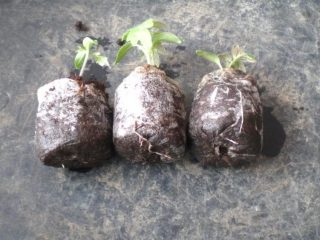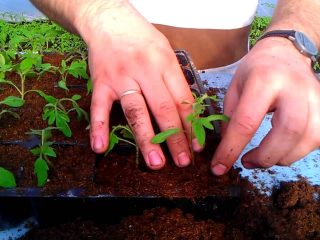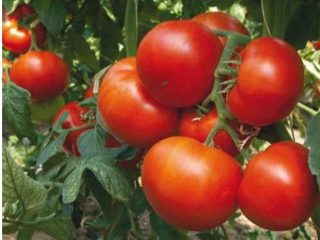Content
The Sweet Bunch tomato is a relatively new variety with small, round fruits covered with smooth red skin and dense, sweet pulp. It is valued for its uniform ripening of clusters and is suitable for growing in protected ground.
Where and when appeared
The Sweet Bunch tomato was bred in 2008 by a group of Russian breeders. The authors of the variety are considered to be I. N. Dubinina, S. V. Dubinin and A. N. Lukyanenko.

The Sweet Bunch tomato was included in the State Register of the Russian Federation in 2009
Description of the tomato variety Sweet bunch
The culture belongs to tall plants of the indeterminate type. Its powerful bushes are prone to weaving and stretch up to 2.5 m in length.

The plant has a developed root system, a strong central stem, flexible side shoots and moderately dense dark green foliage.
Beautiful round fruits, without any irregularities, are small in size and weigh on average 15-25 g.They are covered with dense, smooth, shiny skin and have fleshy juicy pulp with a small number of small seeds. The color of tomatoes depends on the degree of ripeness. At the ripening stage, the fruits are green; when ripe, they turn red. Tomatoes are collected in clusters, the number of fruits on which varies depending on the location on the bush.
Characteristics of tomato Sweet bunch
Cherry tomato Sweet bunch is a popular variety characterized by resistance to typical diseases and high yield. It is valued for its long, abundant fruiting; it is successfully grown in open and protected ground.
Ripening time
The Sweet Bunch tomato is an early variety. Ripe tomatoes appear on the branches 90-100 days after the massive seed hatching. The variety is characterized by abundant and extended fruiting, lasting until autumn.
Tomato yield Sweet bunch
The variety is characterized by a fairly high yield. With minimal care, you can harvest at least 3.5 kg of ripe tomatoes per season from each bush.
Resistance to diseases and pests
Sweet bunch tomatoes are immune to most contagious tomato diseases. When grown outdoors in regions with unfavorable meteorological conditions, plants become vulnerable to late blight.
In what regions is it grown?
The variety is recommended for cultivation in the Far Eastern, East Siberian, West Siberian, Ural, Lower Volga, Middle Volga, North Caucasus, Volga-Vyatka, Central, Northwestern and Northern regions.In areas of central Russia and Siberia, Sweet Bunch cherry tomatoes are best grown in greenhouses. In areas with hot and long summers they can be planted in open ground.
Methods of application
The Sweet Bunch tomato is a dessert variety of the cherry type. Its fruits have a pleasant sweet and sour taste and a pronounced spicy aroma, thanks to which they are widely used in cooking. They are eaten fresh, frozen, pickled and used in salads.
Advantages and disadvantages
The Sweet Bunch tomato is popular due to its small size and pleasant sweet and sour taste of the fruit. It is recommended for cultivation in all climatic zones of the Russian Federation, but is most productive when planted in film greenhouses. Tomatoes are covered with a shiny and fairly tough skin that can be felt when eaten raw. It protects fruits from cracking and deformation during heat treatment.

It is recommended to pick small fruits of the Sweet Bunch variety in whole bunches
Pros:
- pleasant taste;
- early ripening;
- extended fruiting;
- suitability for whole-fruit canning.
Minuses:
- susceptibility to late blight;
- the need for tying and pinching.
How to plant
The Sweet Bunch tomato is grown by seedlings in both open and protected ground. From late February to mid-March, seeds are sown in any suitable containers filled with moistened purchased soil substrate or a mixture of equal amounts of sand, peat and garden soil. Before planting, they are treated with a weak solution of potassium permanganate and soaked in a growth stimulator for at least 30-40 minutes.The treated seeds are deepened several centimeters and covered with glass or transparent film to create a greenhouse effect.

If the crops are kept under 12-hour daylight conditions and at a temperature of 22-25 0C, they will sprout in 5-7 days
After the first shoots appear, the film or glass cover is removed from the container, and the ambient temperature is slightly reduced. When several true leaves form on the plants, they are picked and planted in individual peat cups.

For the first time, seedlings are fed with liquid complex formulations before planting in a permanent place.
Transplantation is carried out approximately 50-60 days after sowing the seeds, when the bushes have 5-7 true leaves. In a selected area with fertile soil, dig holes so that 1 m2 there were no more than three bushes. The seedlings are carefully removed from the containers, trying not to disturb the earthen ball, and planted in prepared holes. Finally, the bushes are watered abundantly with non-cold, settled water and provided with reliable support.
Care instructions
Although the Sweet Bunch tomato is easy to care for, to increase productivity and improve the taste characteristics of the fruit, gardeners will have to follow the basic rules of agricultural technology, which include:
- Watering. Irrigation is carried out weekly, focusing on the current condition of the soil. Watering is carried out using the drip method using warm water. The soil under tomatoes is moistened early in the morning or late in the evening after sunset.
- Fertilizer application. During the entire growing season, the bushes are fed 3-5 times. During the period of active growth, nitrogen-containing fertilizers are applied to the soil. Later, the plants are fed with complex and mineral compounds.
- Soil treatment.1-2 days after each watering, the soil under the tomatoes is loosened to ensure the flow of oxygen to the roots and to prevent stagnation of moisture, which provokes the development of fungal diseases. Also, the tree trunk circle is weeded to remove weeds that absorb nutrients and moisture from the soil.
- Formation of plants. Bushes are formed into 1-2 stems, promptly tearing off wilted leaves, dried out and excess shoots. The plates growing in the lower part of the bush are removed gradually, 1-2 pieces at a time, so as not to cause cracking of the fruit. The foliage is torn off until all the specimens located under the first fruit cluster are removed. To support the branches, props and garters are used.

Sweet bunch tomatoes require a mandatory garter
Tomatoes form additional roots, which should be covered with soil.
Pest and disease control
The Sweet Bunch tomato is immune to the main “tomato” diseases, but when grown in drafts and in conditions of high humidity it becomes vulnerable to late blight. This disease is caused by fungi living in the soil and is accompanied by the appearance of brown spots and white coating on the leaves.

Gradually, the infected plates turn yellow and dry out completely.
The disease also affects the stems and fruits of tomatoes. The shoots of the plant darken, and unripe tomatoes begin to quickly turn black.
You can get rid of the disease by cutting off and burning the affected plant fragments. It is better to treat the bushes themselves with special preparations.Fungicides such as Skor, Coronet, Thanos, Tridex (Penncozeb) and Revus Top have proven themselves well in the fight against late blight.
Conclusion
The Sweet Bunch tomato is an early indeterminate variety bred by Russian breeders. Its fruits have an interesting sweet and sour taste and are used for making juices, preserves and salads.
Reviews from gardeners about the Sweet Bunch tomato








